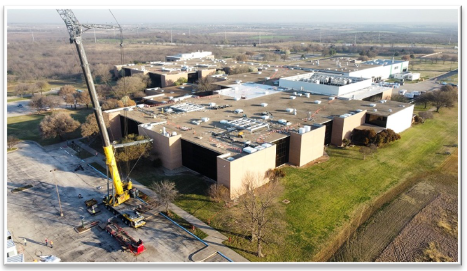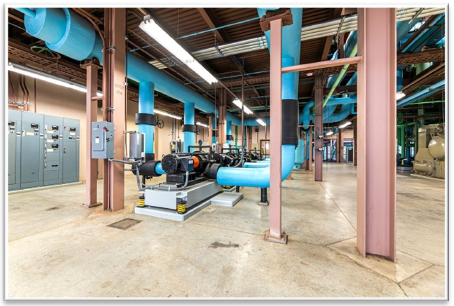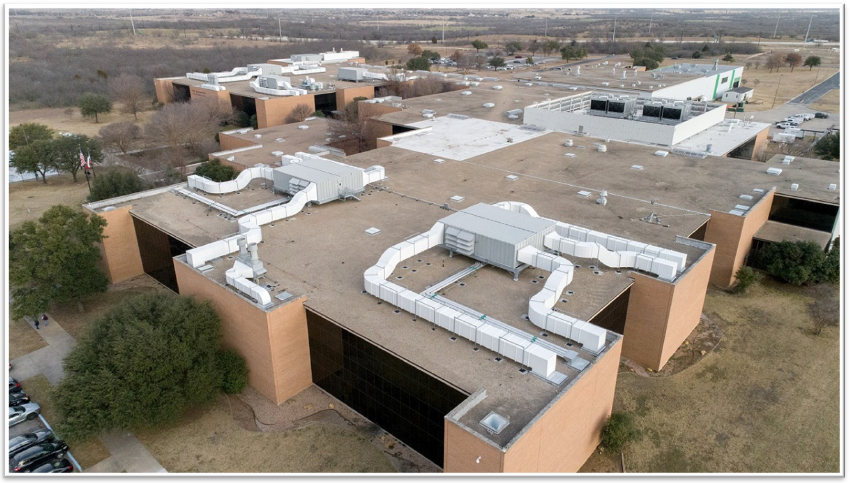Over the decades, the location that now houses Discovery Park at the University of North Texas (UNT) in Denton, Texas, has experi-enced dramatic shifts in functionality and ownership. The structure was initially built in 1988 by Texas Instruments as an assembly manufacturing facility for electronic defense systems. However, after completion, the building never saw use as a manufacturing facility, leaving it vacant until about 2001. UNT then bought the site and breathed new life into the facility. Today, the 609,550-square-foot, two-story Discovery Park facility educates UNT’s College of Engineering and College of Information students, serving hundreds each year.
The building hosts a variety of spaces with diverse needs, from classrooms, offices, and a cafeteria to around-the-clock research labs and data centers. Although the facility had been cared for well, the central utility plant and much of the air distribution systems were being operated with equipment original to the building well past their useful service life.
SpawGlass Contractors, Inc. was hired as the construction manager-at-risk to coordinate and execute a scope of work that included replacing 1,800 tons of chiller capacity; 3,600 tons of cooling tower capacity, and 11 hydronic pumps in the central utility plant. The project also included the replacement of 32 air handling units located in mechanical rooms throughout the building with 10 new 35,000 CFM roof-mounted air handlers, two large high-plume exhaust fans and over 300 VAV and exhaust terminal units. Through 12 months of design and 10 months of active construction, SpawGlass worked with the facility management, engineers, trade partners, and end users to complete the project, while the facility remained operational. A key to the project’s success was focusing on system shutdowns and implementing several strategies to eliminate or mitigate their impacts.
Eliminate the Shutdown
The best shutdown is no shutdown, and the team focused on eliminating them where they could throughout the project. Pinpointing shutdowns began at the project’s design. The team reviewed new work that tied into old systems to identify if connection points could be simplified or reduced. For points that remained, line freezes and hot taps were used. When addressing equipment replacement, the team sequenced work off peak demand season and deconstructed groups of equipment one half at a time. These strategies were most apparent when replacing pumps throughout the central utility station. Replacements were staged so that two of the set of four pumps would be running while the other two were replaced.
Sometimes shutdowns cannot be avoided, and this was no different during the Discovery Park project. Several shutdowns were needed to the normal power system to remove and replace two large medium voltage substations in the central utility plant. Advanced communication was vital between the team and building occupants to avoid disruptions and ensure adequate time for preparation. The project team capitalized on these shutdown periods by installing breakers in downstream electrical gear and combined critical overhead lifting activities for the rooftop air handling units.
Moving Work out of Sensitive Areas
Several research laboratory rooms in Discovery Park contain large instruments that cannot be moved or shut off. These instruments are susceptible to dust, vibration and temperature variations, so work around them carried significant risk. A portion of the scope called to rework and demolish ductwork in the rooms and to route several return duct pathways serving adjacent spaces through them. After discussing as a team, it was decided to cap the ductwork outside the rooms and leave the instruments in place. The return ductwork was routed through an adjacent hallway, and all work was kept out of the rooms.
Adding Valves

The new roof-mounted air handling units required new branch lines tied into the existing hydronic piping loops. Additionally, old branch lines serving the demolished air handlers needed to be removed and capped. Though these tie-ins were done by using line freezes to avoid draining down the entire building system, large sections of the hydronic loop still had to be valved off to avoid excess pressure on the frozen section. Altogether, 32 line freezes were needed to keep the project on pace. This work was completed at the beginning of the project during a low-demand cool season, where the loss of chilled water circulation during the workday was a minor impact on building occupants. By using valves instead of capping off old sections, the team was able to leave the old air handlers running until demolition activities were ready to start and avoid shutdowns of the chilled water system during the peak demand of the summer.

Communication
Ultimately there will be many shutdowns that can’t be eliminated. However, projects like UNT Discovery Park can be executed as painlessly as possible for everyone involved through clear communication. A careful approach was taken when addressing the facility’s occupants. Face-to-Face meetings were scheduled with each user group to discuss the work needed, hear their concerns, and set expectations for timelines beforehand.
The construction team also scheduled a walkthrough alongside all involved parties before the shutdowns to discuss the steps of the operation and everyone’s role. Points of contact were established for each team, along with proper channels of communication. Contingencies were also placed detailing what steps would be taken to re-energize the system if things didn’t go according to plan.
Conclusion
The Discovery Park project was extremely challenging in part be-cause it required many shutdowns throughout the building, which affected a diverse group of end users with a range of system needs. With a focus on eliminating and minimizing system shutdowns from the start of design, the two-year project was accelerated to completion in just over 10 months while ensuring the facility remains healthy for decades to come.
Submitted by Joe Martin, Marketing Specialist, SpawGlass, Inc.

